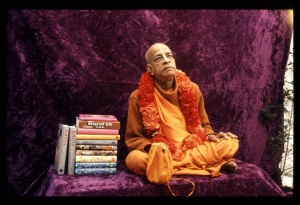CC Madhya 9.134: Difference between revisions
m (1 revision(s)) |
No edit summary |
||
| Line 1: | Line 1: | ||
{{ | [[Category:Sri Caitanya-caritamrta - Madhya-lila Chapter 09|C134]] | ||
<div style="float:left">'''[[Sri Caitanya-caritamrta|Śrī Caitanya-caritāmṛta]] - [[CC Madhya|Madhya-līlā]] - [[CC Madhya 9|Chapter 9: Lord Śrī Caitanya Mahāprabhu's Travels to the Holy Places]]'''</div> | |||
<div style="float:right">[[File:Go-previous.png|link=CC Madhya 9.133|Madhya-līlā 9.133]] '''[[CC Madhya 9.133|Madhya-līlā 9.133]] - [[CC Madhya 9.135|Madhya-līlā 9.135]]''' [[File:Go-next.png|link=CC Madhya 9.135|Madhya-līlā 9.135]]</div> | |||
{{CompareVersions|CC|Madhya 9.134|CC 1975|CC 1996}} | |||
{{RandomImage}} | |||
==== TEXT 134 ==== | ==== TEXT 134 ==== | ||
<div | <div class="verse"> | ||
bāhyāntare gopī-deha vraje yabe pāila | :bāhyāntare gopī-deha vraje yabe pāila | ||
sei dehe kṛṣṇa-saṅge rāsa-krīḍā kaila | :sei dehe kṛṣṇa-saṅge rāsa-krīḍā kaila | ||
</div> | </div> | ||
| Line 12: | Line 16: | ||
==== SYNONYMS ==== | ==== SYNONYMS ==== | ||
<div | <div class="synonyms"> | ||
bāhya- | ''bāhya-antare''—externally and internally; ''gopī-deha''—the body of a ''gopī''; ''vraje''—in Vrajabhūmi; ''yabe''—when; ''pāila''—they got; ''sei dehe''—in that body; ''kṛṣṇa-saṅge''—with Kṛṣṇa; ''rāsa-krīḍā''—pastimes of the ''rāsa'' dance; ''kaila''—performed. | ||
</div> | </div> | ||
| Line 19: | Line 23: | ||
==== TRANSLATION ==== | ==== TRANSLATION ==== | ||
<div | <div class="translation"> | ||
“The personified authorities on the Vedic hymns acquired bodies like those of the gopīs and took birth in Vrajabhūmi. In those bodies they were allowed to enter into the Lord’s rāsa-līlā dance. | “The personified authorities on the Vedic hymns acquired bodies like those of the gopīs and took birth in Vrajabhūmi. In those bodies they were allowed to enter into the Lord’s rāsa-līlā dance. | ||
</div> | </div> | ||
__NOTOC__ | |||
<div style="float:right; clear:both;">[[File:Go-previous.png|link=CC Madhya 9.133|Madhya-līlā 9.133]] '''[[CC Madhya 9.133|Madhya-līlā 9.133]] - [[CC Madhya 9.135|Madhya-līlā 9.135]]''' [[File:Go-next.png|link=CC Madhya 9.135|Madhya-līlā 9.135]]</div> | |||
__NOTOC__ | |||
__NOEDITSECTION__ | |||
Revision as of 10:53, 24 August 2021
Śrī Caitanya-caritāmṛta - Madhya-līlā - Chapter 9: Lord Śrī Caitanya Mahāprabhu's Travels to the Holy Places

His Divine Grace
A.C. Bhaktivedanta Swami Prabhupada
A.C. Bhaktivedanta Swami Prabhupada
TEXT 134
- bāhyāntare gopī-deha vraje yabe pāila
- sei dehe kṛṣṇa-saṅge rāsa-krīḍā kaila
SYNONYMS
bāhya-antare—externally and internally; gopī-deha—the body of a gopī; vraje—in Vrajabhūmi; yabe—when; pāila—they got; sei dehe—in that body; kṛṣṇa-saṅge—with Kṛṣṇa; rāsa-krīḍā—pastimes of the rāsa dance; kaila—performed.
TRANSLATION
“The personified authorities on the Vedic hymns acquired bodies like those of the gopīs and took birth in Vrajabhūmi. In those bodies they were allowed to enter into the Lord’s rāsa-līlā dance.